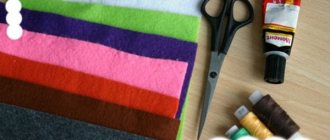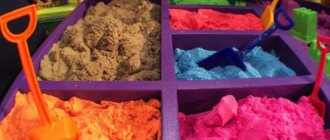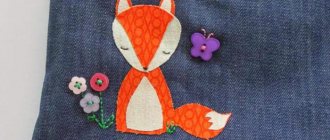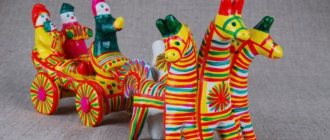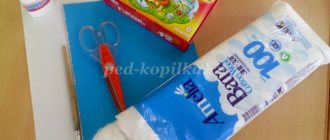How to sew an apron
First, choose the appropriate fabric for the apron.
In this case, it is waffle cotton fabric with a decorative pattern. Fabric consumption: from 1.0 m to 1.4 m, depending on how the coupon is placed on the fabric.
You will need tools: sharpened soap or chalk, ruler, measuring tape, tailor's scissors, thread, needles, safety pins.
Preparing for cutting
Before you start cutting on fabric, you need to decate the fabric, i.e. check for shrinkage, iron using steam, observing the temperature regime.
Next, lay the fabric out on a table or flat surface so that it is convenient for you to draw the pattern lines. The lines are applied on the wrong side of the fabric, but in our case, we will apply the lines on the front side, since the fabric has a pattern, so as not to make a mistake.
Square apron
A chef's apron is easy to sew from a square piece of fabric. On a flat table surface, lay the fabric at an angle facing you. The size of the side of the figure is measured in accordance with the selected length.
The lower triangle is trimmed with edging made of contrasting fabric, the upper corner is folded down and decorated with a triangle made of the same material. Sew a button in the center to hold the flap in place. Waist ties are not attached to the corners of the square, but slightly higher. The pocket is designed in the same style, with a triangular flap on top. The top tie from a strip of fabric is sewn on both sides at once and the apron is put on over the head. The product looks incredibly feminine, and the tailoring, as you noticed, is quite simple. The seams are made along straight lines, so even a novice master can cope with the work.
Theme options
According to the traditional drawing program for the middle group, the topic “Decorating a Sweater” is offered to students in November. This is logical, since the cold season comes when people change into warm clothes. The teacher is invited, at his own discretion, to replace this activity by decorating the skirt with a young lady’s haze. Nevertheless, it is quite possible to decorate a sweater with a Dymkovo pattern - then the topic of the lesson will sound more specific and the children will practice certain techniques of decorative and applied art.
Another option for decorative drawing is “Let's decorate a sweater with snowflakes” (this activity can be done when the first snow has already fallen, so it will be more interesting for the kids). At the same time, the teacher offers blanks (preferably blue, light blue, purple), and the children decorate them with simple snowflakes.
The theme can also be designated as “Lace Sweater”. To do this, the teacher prepares color templates in rich tones, which preschoolers decorate with white gouache - it will create the appearance of openwork knitting.
White paint realistically depicts the openwork knitting of a sweater
Shortly before one of these classes, the teacher offers the kids the topic “Decorating an Apron,” where they decorate a simpler piece (October). It is also advisable to practice with children in advance in decorating other simpler silhouettes, for example, a scarf, hat, napkin, handkerchief. Also very useful will be the preliminary application - “Decorate a napkin” (September): the children will be able to practice compositional skills (arrange the pattern not chaotically, but in a certain order, evenly filling the middle and corners with elements).
Summary of the lesson “Decorating an apron” in the middle group
The outline includes not only planning the activities of students in the classroom, but also indicating the educational significance and material resources:
- Target.
- Tasks.
- Preliminary work.
- Equipment and materials.
- GCD plan: Organizational moment - 1 minute.
- Visible information stage - 3–4 minutes.
- Practical part - 13–14 minutes.
- Display of works, summing up - 2 minutes.
Important. The practical part should contain 1-2 dynamic pauses: finger play or physical education. Children 4–5 years old find it difficult to engage in one activity for more than 4 minutes.
Children love to show drawings, be sure to discuss their work, praise them, arrange exhibitions
Table: summary of GCD for decorative drawing according to the Federal State Educational Standard in the middle group “Decorating an apron”
| Author | Mokrousova T. |
| Tasks |
|
| Equipment |
|
| GCD move | Hello guys. Autumn and I are waiting for you. But for some reason she is very sad? Autumn, why are you so sad, aren’t you glad to meet us again? - Well, I really love coming to visit you. And I’m sad because guests are supposed to come to me tomorrow, I’ll bake a cake and I’m very afraid of getting my new dress dirty. - No need to be upset. Come on, Autumn, let's ask the guys what needs to be done so as not to get dirty? Children's answers. - That's right, guys, you need to put on an apron. - Look, Autumn, we have aprons and we are ready to help you. But they are not decorated at all. The guys and I will help you color it for you. Do you guys agree? — I have several aprons with different patterns, let's look at them. —What is this apron decorated with? —Where are the stripes on the apron? — Do you know how to draw a stripe? You need to place the entire bristle of the brush on the paper and draw a line from left to right without lifting the brush from the paper. — What is the pattern between the stripes? - That's right (leaves and flowers). How are they located on this apron? - What a great fellow you are, of course, one leaf is on the right, the other is on the left, and between them is a flower. What do the flowers look like? - That's right, into circles. What color are the leaves? - Well done, green, of course. And the flowers? - Great, well done, the flowers are red. - How can we draw leaves? You need to attach the brush with all its bristles to the paper and remove it - now our leaf is ready. - How to draw a flower? — Let's look at the pattern of the second apron. Is it similar to the first one? - That's right, guys, this apron has a different pattern. Three flowers in the middle, and between them two leaves. Let's look at both aprons again, how are they similar? — That’s right, the elements of the pattern are the same: leaves, flowers and stripes. — Tell me, where will you start decorating your apron? — That’s right, of course, with stripes, and between the stripes we’ll draw a pattern of leaves and flowers. We draw stripes from left to right, without stopping with one movement of the brush and without tearing the brush off the paper. Draw the stripes further apart from each other. Don't forget to leave room for the pattern. - Think about how your pattern will be located, how many flowers and leaves you will draw. Physical exercise “We pressed our hands to our shoulders” - Those who have already come up with a pattern, start drawing. Keep your back straight, the tips of your tassels pointing upward. - And Autumn and I will watch you draw. If anyone needs help, Autumn and I will help. Let us remind you how to bathe a brush, how to apply paint to a brush, and remove excess paint on the edge of the jar. - Now let's look at our work. You too, Autumn, look. Do you like our aprons? - Of course, I like it! “We’re giving you these aprons so that you don’t get your dress dirty when you bake a cake for the guests.” - Guys, now let's say goodbye to our guest. - Now we need to clean up our workplace. - You guys are great, you did a good job. What do you remember most? Guys, were we able to help Autumn? How did we help her? What did you like about the lesson? What was difficult for you to do? How did you help Autumn? What have you learned? Autumn thanks everyone for the wonderful aprons. |
| Quote from: https://www.maam.ru/detskijsad/dekorativnoe-risovanie-po-fgos-v-srednei-grupe-ukrashenie-fartuchka.html | |
The guys decorate aprons for guests - Autumn
The lesson notes can be drawn up in the form of questions and phrases that the teacher will pronounce. The only remark is that the author should have broken down the GCD progress into stages. Based on the column of questions, it will be difficult to quickly determine at what point the lessons stopped. Ideally, you need to practice decorative drawing techniques with gouache. But watercolor is cheaper, so the author does the right thing by reminding children how to handle this paint.
Apron styles for the kitchen
Once the fabric issue is resolved, you should choose your preferred style so that you don't get bored with it after a few months.
From the variety of styles, it is recommended to choose the most popular ones, which are traditionally used for sewing such products:
- A regular apron highlighting the bodice area. This is a rather bright and feminine kitchen accessory.
- A classic sundress made from a single cut. In it, both main components - the chest and the hem - form a single whole, for this they are cut out according to one template. But to sew the main part you need to use one type of fabric, and to create the ties and harness - another.
- Aprons in the form of a Russian scarf. They are usually diamond-shaped and decorated with small fringes.
- Apron-skirt. Among its features, it is worth highlighting the absence of an upper part; the hem of the apron is sewn by connecting three “floors of narrow” stripes into a fold;
- Apron in the “Marilyn” style. It is distinguished by a low-cut area and a fluffy hem. It is best to sew it from bright fabric with large polka dots.
- Traditional apron with lace border. It is made from linen and has a pocket on the chest.
- Apron made of thick denim. In addition to the main elements, it has a side satin pocket in the shape of a rectangle, strict and long.
Even a novice seamstress can create such creations with her own hands. But for this you will have to carefully consider the design of the apron. It doesn’t hurt to make changes to the standard style by decorating it with different decor - you can add lace and braid, and also sew bright pockets where you think is right. You can also abandon the rectangular shape of the hem and choose another one that seems more interesting to you - in the form of a triangle, an arc, or asymmetrical.
Making a pattern
Making an apron pattern with your own hands is very simple. You just need to follow the procedure:
- First you need to take measurements;
- We make a sketch of the future product;
- We draw up a drawing of the pattern, observing the dimensions, or you can use a ready-made model from the application with patterns, which can be found in many sewing magazines;
- Now the apron design needs to be transferred to the fabric, remembering to leave seam allowances to minimize mother waste;
- If you were able to complete all of the above steps without errors, then you can start cutting the fabric.
When making any thing with your own hands, the well-known folk wisdom becomes especially relevant: “Measure twice, cut once.” It follows from this that before you start cutting the fabric, check again that the contours of all the parts are transferred to the fabric correctly, and the grain threads and the pattern are in the right direction. To create versatile pieces, you will have to make two patterns in a mirror image or flip one so that you get the correct fabric pieces. Otherwise you will have two left or two right parts.
Often in old publications you can find instructions that an apron can be sewn in any shape, but it must have pockets. Many modern aprons have this element, but this does not mean that you will have to include it in the pattern of an apron you make yourself. It all depends on the housewife’s personal view of this element and her position regarding convenience. A pocket wouldn't hurt, because you can store useful little things in it. Others, on the contrary, will consider it inappropriate due to the fact that garbage will constantly accumulate there, which is high time to get rid of.
Let's decorate the apron with a pattern
Contained in sections:
Master class on making a postcard using the applique technique “Apron for Grandma”
Master class on postcards using the appliqué technique: “
Apron for Grandma ” Autumn continues to delight us with numerous holidays, so my preschoolers and I prepare for them in advance.
And today we started making gifts for grandparents in order to be in time, since there will be two of them waiting. Summary of an open lesson on the application “Matryoshka - a flowered apron” in the middle group. Notes of an open lesson on the application in the middle group “Matryoshka.”
Educator: Barasheva Oksana Valerievna MDOU
"Kindergarten No. 105" "Matryoshka -
a flowered apron " The purpose of the NOD: to expand the understanding of the Russian folk toy
"Matryoshka."
Priority educational tasks.
DIY apron
Most women are forced to spend hours in the kitchen performing various tasks. However, even here they want to look beautiful. By sewing an elegant apron, even a tired housewife can instantly turn into a tireless, radiant flylady. Everyone who is familiar with this popular system knows one of its key principles - it will be easy for a woman to cope with her household chores if she wears beautiful and comfortable clothes.
Exclusive models
Housewives who care about their appearance certainly have two aprons, one of which is used for everyday cooking, and the other is worn on special occasions. For example, you can put on an apron when guests are already sitting at the table, and you have not yet brought the dishes with which you are going to please them.
Naturally, a festive apron should have an appropriate design. The ideal color scheme is white. If you wish, you can add additional decor to it:
- shuttlecocks;
- frill
- lace trim.
Thus, it will no longer be just work clothes, but a flirtatious detail of the hostess’s toilet.
An interesting trend has been observed recently. Increasingly, we have to turn to long-forgotten things, abandoning soulless and uniform industrial products. Even a banal apron can be turned into a real work of art with the right approach. Exclusive decor can be created using a variety of techniques:
- satin stitch and cross stitch embroidery;
- applications;
- knitting;
- patchwork, etc.
Ideas from old magazines
A housewife does not always have enough ideas to create a truly beautiful and original apron for the kitchen. In this case, you should turn to old books on home economics or the Internet. For example, few people know that you can make an apron with your own hands from four large handkerchiefs or bandanas. And, given that the source material will have different colors, you can get a rather unusual color combination of kitchen utensils.
In the time of our grandmothers, women devoted a lot of time to careful housekeeping. Therefore, they did not throw away things that had served their purpose, but found new uses for them. For example, an ordinary men's shirt can become an excellent source material for making a kitchen apron. Many other interesting ideas for using old items can be gleaned from old magazines.
Work clothes for all family members
The choice of material and ideas for an apron are important and relevant issues for every housewife. But besides this, it is necessary to understand whether only the hostess will use it or whether other family members will also wear it. It's no secret that in some families men also have to perform women's duties in the kitchen. And, of course, the spouse will not experience great delight when he sees himself dressed in an elegant and flirty apron with lace frills.
Therefore, you need to immediately think through this moment and choose a pattern for an apron so that it looks beautiful on both a man and a woman. It is best for the apron or apron to be made from neutral-colored fabric. It can be green, blue, or different shades of beige.
Don't forget about children. You can sew special aprons for them - separate for boys and girls. A child who has his own kitchen clothes for work will feel more confident and will be able to realize his importance and usefulness, and parents will likewise be able to arouse children's interest in household chores.
↑ Choosing fabric for an apron
For the simplest detail of a modern woman's kitchen suit, choosing the right fabric is not so easy; several important factors need to be taken into account.
- The kitchen is a place where the risk of getting clothes dirty increases many times over, and it is the apron that should protect it from possible stains, taking the blow on itself. The apron will have to be washed quite often, and stains on it can be difficult to remove, so it is desirable that the chosen material is durable and easy to clean, and can also withstand the effects of aggressive cleaning agents.
- The choice of color for an apron is determined by personal preferences, and there are no strict rules here. The housewife can choose the color of the fabric taking into account the overall style of the kitchen, or she can choose colors that, on the contrary, will contrast with the color scheme of the interior.
- Stains on a plain fabric are usually more noticeable than on a multi-colored one, therefore, even a dirtier apron made of colored fabric will look neater than a plain one, but this does not mean that you can wash it less often.
- Plain fabrics of dark colors will hide stains of dirt, but will make you so bored that kitchen work will turn into an unpleasant chore, and to prevent this from happening, it is not recommended to choose them only for practical reasons.
- The black color of an apron is ideal for dirty work in the kitchen, but it has a depressing effect on the people’s psyche. The white contrasting details of this apron make it not only attractive, but also flirty.
- Psychologists have determined that colors affect people differently. For example, the color red and its shades stimulate the appetite and lift the mood, which is why plain red, red with white checkered or polka dot aprons have been popular among housewives for many years. In addition, red suits many women.
All these rules apply mainly to those aprons that will play the role of an important decorative element in the kitchen. If we are talking about a means of protecting the housewife’s clothes, then you can simply take an old dress that no one wears anymore, but it would be a pity to throw it away. A good option could be an apron made from jeans that have already served their purpose.
Fantasy and the desire to be unique suggest original ideas for using old denim items. Guests will definitely pay attention to such workwear.
Tile
Create a mosaic backsplash with your own design using small tiles in different colors. For example, in this case, dark brown floor tiles were needed.
You can also create a mosaic pattern by breaking large tiles into smaller pieces before attaching them to the wall. The result is similar to the previous one, but more chaotic, without clear lines.
If you like more formal shapes and colors, then pay attention to this combination of small tiles in white, brown and gray:
When using very small tiles, it seems that the colors transform into each other and shimmer. In the example in the photo, a dark color scheme was chosen, but with such tiles you can experiment with even the brightest colors.
The shape of the tile has a great influence on the result, for example, taking a hexagonal tile instead of a square one immediately achieves an original effect. It is especially good to take hexagonal tiles, which have some color transitions, like here from white to gray:
Using tiles you can achieve a 3D effect. To do this, lay the tiles not side by side at the joint, but overlapping each other, creating volume. For example, like in this case:
How to sew an apron 5th grade technology, in detail.
To begin with, as with sewing any product, you need to create a pattern. We have already told you above how to take measurements. So. Our pattern will consist of 2 rectangles 50*35 - the bottom of the apron, 20x22 cm - bib, 14x14 cm - pocket, 2 parts 6x40 cm for the straps and belt.
1. Fold the fabric in half. Pin the pattern onto the fabric using pins. We pin the top of the apron at a distance of 2 cm from the top.
2. Next, along the fabric, pin the remaining parts of the pattern, 1 cm each for a seam allowance.
3. Using chalk, pencil or soap, outline all the details of the future apron, adding 1 cm to the sides per seam.
4. After all the details have been applied to the fabric, they need to be cut out without breaking the pattern off from the fabric.
The apron is ready to open.
5. Let's start sewing the apron. Let's start with the straps. Fold each piece in half face to face. Next, take the iron and iron it thoroughly. Then take a ruler and, using a pencil, draw lines along the edge at a distance of 0.5 cm.
6. Next we sew the edges. We leave one narrow edge unstitched. This is necessary in order to turn the straps out.
7, Turn it inside out. We do the same with the second strap. After the parts have been turned out, they need to be ironed thoroughly.
8. Take the bib piece and unfold it. We place one part of the strap on the fold of the bib, and the second part on the edge, 1 cm from the edge.
9. Cover with the other half of the bib and pin in several places, namely: the top of the straps and on the side. You need to pin it on the side so that the strap does not get caught in the seam.
10. Sew the parts. The seam lines are indicated in the picture with black arrows.
11. Turn the bib inside out and iron it out. The bib is ready.
12. Take our pocket, secure it with pins and sew it on, leaving the entrance to the pocket open.
13. Fold the bottom of the apron 1 cm inward and stitch. For greater convenience, the seam can be ironed first.
14. After all the parts are ready, they need to be sewn together. Find the middle of the belt and the middle of the bib. We put the bib into the belt and sew it on. This is the detail you should get.
15. We sew the lower part of the apron in the same way.
Okay, let's iron everything. The apron is ready!
Progress of the lesson:
1 part. Introductory
Educator: Hello, guys. Mishutka and I are waiting for you. Mishutka, but why are you so sad, aren’t you happy to meet the guys?
Mishutka: What do you mean, I really like to come to visit you and meet the guys. But guests are supposed to come to me tomorrow, I will be preparing a treat and I’m very afraid of getting my fur coat dirty.
Educator: Come on, Mishutka, let’s ask the guys what needs to be done so as not to get dirty?
(Children's answers)
.
That's right, guys, you need to put on an apron . aprons we have .
Mishutka: I see, but they are not decorated .
Educator: The guys and I will help you decorate them . Do you guys agree? (Children's answers)
.
I have aprons with different patterns . Let's take a look at them. What is this apron decorated with ? (Children's answers)
.
That's right, stripes. are the stripes located on ? Below the apron . Do you know how to draw ? You need to attach the brush with all its bristles to the paper and remove it - the leaf is ready. How to draw flowers ?
Okay, let's draw a circle and fill it in. Guys, you know, you can draw with a colored finger : put paint on your index finger and apply it to the paper - the flower is ready. Then we wash our finger and dry it on a napkin. What is the pattern between the stripes? That's right, leaves and flowers. How are they located on this apron ?
Well done, of course there is a leaf on the right, another on the left, and a flower between them. What do the flowers look like?
That's right, into circles. What color are the leaves?
Well done, green ones. And the flowers?
Wonderful, well done, the flowers are red.
Let's look at the second apron . What changed?
That's right, guys, this apron has a different pattern . Three leaves on the left, right and between them, flowers next to them and again three leaves. Let's take a look at both aprons . How are they similar? That's right, the elements of the pattern are the same: leaves, flowers and stripes.
Tell me, where should we start decorating our apron ? That's right, from the stripes, then between the stripes we will draw a pattern of leaves and flowers. We draw stripes from left to right, without stopping with one movement of the brush. Don't forget to leave room for the pattern.
Think about how you will arrange them: leaves and flowers. Who has already come up with a pattern, start drawing . Keep your back straight.
Part 2. Independent activity of children.
Educator: Mishutka and I will watch you draw.
Individual assistance, verbal instructions, showing in your silhouette, encouragement, reinforcement. (What element are you drawing? What color? Where are they located? How to “bathe”
brush)
Part 3. Analysis of children's works.
Educator: Whoever has already decorated the apron , bring it to our shelf. Let's take a look at them. And look, Mishenka. Katya, find an apron with an even pattern . Why did you choose this apron ? Well done, because the stripes are drawn evenly and the pattern between them is neat. The leaves are drawn on the left , on the right, and between them are flowers.
Educator: Misha, do you like our aprons ?
Mishutka: Of course I like it.
Educator: We give them to you so that you don’t get your fur coat dirty when you treat your guests. Guys, let's say goodbye to our guests. Now we need to clean up our workplace. Well done guys, you did a good job.
Summary of a drawing lesson in the middle group “Fox” Program content: 1. Visual task: draw a fox based on an oval and a circle, convey the structure, name the color orange.
Notes on drawing in the middle group “Decorating an apron for a nanny” Program tasks: Strengthen the ability to paint. Teach children to make a simple pattern using elements of folk ornaments on a strip of paper.
Summary of the drawing lesson “Firebird” in the middle group Date: 02/13/2019 Topic: Drawing. "Firebird" Cultural practice: productive activity. Form of presentation of the goal: work according to the model.
Summary of the lesson “Decorating a duck” on decorative drawing in the middle group Decorative drawing. Topic: “Duck Decoration” Program content: Continue to get acquainted with the Dymkovo toy, the features of the pattern;
Summary of a drawing lesson in the middle group "Bus" Summary of a lesson in visual activity in the middle group "Alyonushka" Drawing "Bus" Prepared by: teacher A.N.
Summary of the lesson on drawing “Butterflies” in the middle group Hello dear colleagues! I bring to your attention a summary of a lesson in the middle group on unconventional drawing: klyasography, etc.
DIY children's aprons for the kitchen
If you sewed an apron for yourself, then it’s time to think about the children. Moreover, you don’t have to do everything yourself; you can involve the future owner in the process of sewing the apron. Try to bring him up to date - what fabric the apron pattern will be made from, what style it will have, how you will decorate the apron with a bib.
For a children's apron, a similar sewing technique is used as in the case of an adult apron. True, you should place more emphasis on decorating this product.
We sew an apron with a bib for a child with our own hands
The first step is to take your child's measurements. After this, based on the results obtained, draw up a pattern on paper. Next, you need to cut it out and attach it to the fabric, using chalk to mark the outline of the future product. Usually a satin ribbon is sewn onto the edges of a child's apron, so there is no special need for seam allowances.
When the main part of the apron is ready, you can add details. Although the pockets can be made classic, the baby will be pleased if you show your imagination here and make them in the form of fruit, for example, in the form of an apple or a pear. You can easily find the required template on the Internet.
Before you start sewing on the satin ribbon, you need to fold it in half, iron it and you’re ready to start. To make the edges of the apron look neat, it is necessary to make an edging seam on it. With the harness at the top of the apron, through which the child’s head will be threaded, proceed in the same way as with a satin ribbon - before sewing it, it must be folded in half.
To make pockets, you can choose a fabric that is different from the main part of the product, both in color and texture.
But you don’t have to stop there either. You can go further and decorate your apron with cross stitch on a special border. After this, the resulting elements can be sewn to the top of the apron.
Don’t forget that you are making an apron for a child, and therefore decorate it with appropriate decor - knitted flowers, butterflies made from buttons, funny animal appliqués.
One-piece option
The kitchen apron pattern is made on fabric folded in half. This is the simplest option for doing the job, which is often used when sewing professional aprons for chefs in restaurants and cafes. It is worn by both men and women. This is a strict option that is easy to cut.
Consider the sample pattern of a kitchen apron of this style presented below. The length of the product may vary depending on the height of the person. It is advisable to take the measurements yourself.
Using a flexible meter, measure from your solar plexus to your mid-thigh. If desired, such an apron can be sewn to the knee. The width of the product should cover the front of the body and cover the sides. The height of the sides should reach the waist. When the main measurements are taken, all that remains is to find out the width of the upper narrow part. It can also be different - cover the entire chest or have a narrower upper part (optional).
When the main drawing is completed, think about the design of the ties. You can use satin ribbons or strips of the same fabric in the form of an edging around the entire perimeter. If you do not want to decorate the piping, then leave 1-1.5 cm on all sides for the hem of the fabric. You can leave 3-4 cm on top and strengthen the thin part with a wider fold of fabric.
Apron for dad
In many families, men love to cook, and some even claim to be the best family chef. Therefore, such a man simply needs an apron.
We will sew it from polyethylene, like aprons for children and for mother.
We build a base pattern, substituting our own measurements.
Our sample pattern is made for sizes 52-54.
We cut out an apron and pockets from polyethylene and prepare the bindings.
Pocket width - 68cm, height - 25cm.
The width of the tape is 3.5 cm, and the length:
- 28 cm - for edging the top edge of the apron
- 172 cm - for edging the lower and side (straight) cuts
- 134 cm - for edging concave sections turning into ties (2 pcs.)
- 68 cm - for processing the upper edge of the pocket
- 25 cm - pocket partitions (2 pcs.)
We process the pockets and edges of the apron with trim.
The base of the apron is ready. Decorate with applique from bags and sew on letters.
Application
The picture of the cook was taken from the Internet and printed on A4 sheet.
We cut out a circle from bags folded 4 times, with a diameter of 32 cm.
In our version, the circle is made of two halves, since only narrow garbage bags remain in the rolls.
Next, we sewed a circle to the apron and then decorated the chef. But it's better to do the opposite. First, sew the chef's emblem onto the circle and only then attach the circle to the apron. This makes it more convenient to sew on a sewing machine and prevents creases from forming on the base of the apron.
The chef's face, hands, pants, boots, tie and buttons are made from multi-colored folders - file binders. The shirt, cap and letters are made from a thick white bag.
The eyes, nose and mouth were drawn with a black permanent marker that does not wash off.
The letters were typed on a computer, printed on paper and cut out. The height of the letters was 4.5 cm.
We traced the letters on a thick white bag, cut them out and stitched them onto cellophane tape. Then they sewed it to the product.
The apron for dad is ready.
So we have completed sewing aprons with our own hands for the whole family. They turned out beautiful, comfortable and original. Surely no one has such aprons.
The whole family is now dressed in a chef's uniform and can begin making culinary masterpieces. After all, preparing delicious dishes with a friendly family is great and fun.
We wish you inspiration and creative success!
Preparing for the lesson “Decorating an apron”
Decorative drawing classes for children aged 4–5 years are aimed at solving two main problems:
- develop brush skills,
- develop the ability to put together a pattern from simple elements.
Decorative drawing in the middle group is painting a blank with a brush and paints
Paints and base for painting
- Gouache is the best option for painting an apron. The paint picks up well on the brush (without water), goes on smoothly, and the patterns come out bright and clear. Gouache can be painted on a white or colored background, the decoration will not merge with the base.
- Watercolor is acceptable. But only for drawing on a dense white base. The teacher carefully monitors how the children collect water and paint to remove excess moisture, otherwise they will drip onto the drawing or the patterns will spread.
Gouache is easy to apply to a brush, it is an ideal paint for five-year-olds
- The basis for drawing an apron is usually 1/2 A4 sheet: made of thick white paper, the teacher can pre-tint it with watercolors,
- from colored cardboard.
The teacher can cut out an apron blank for class
Sometimes children are asked to decorate apron blanks with colored pencils. It is not right. Colored pencils are used in the middle group for object drawing. In decorative drawing, kids can use a simple pencil to draw a stencil: they trace the apron on paper.
Techniques and drawing techniques
- Preliminary repetition and training of each technique: children “draw” circles and lines in the air with a dry brush,
- chalk on a blackboard (marker on a special board).
- leaves in a floral design: apply the brush with all its bristles to the paper and remove,
Important. The teacher monitors the completion of the practical task by the children. For those who have difficulty drawing, he shows techniques individually.
Children improve their gouache painting techniques under the supervision of a teacher
This is interesting. Painting an apron can be done with five-year-olds using an unusual technique. The guys will decorate the blanks using non-traditional materials and tools:
- wax crayons,
- cotton swabs or disks,
- pieces of sponge,
- fingers,
- stamps from vegetables or fruits.
It’s easy to make an unusual pattern on an apron by drawing with your fingers on wet paper
Combination with applique and modeling
When creating an “Apron” craft, drawing, applique, and sculpting techniques can be used. An apron painted with a pattern is perfectly complemented by various elements:
- pieces, strips of colored or wrapping paper,
- plasticine mosaic,
- strokes of plasticine,
- dried flowers, leaves,
- buttons, sequins.
The apron pattern can be complemented with a composition of autumn leaves, for example
Kids love decorating with stickers, glitter and other accessories. If access to these materials is opened at the beginning of practical work, the kids will make the craft in the form of an applique from all kinds of pieces and pictures. First, the children draw a pattern, and then the teacher brings a “magic box” with new decorations.
Individualization of tasks
Productive work and a good mood within the group are promoted by simple tasks aimed at satisfying the personal tastes and interests of the children:
- Take apart the apron blanks: round, triangular, with a frill - whoever wants which one.
- To decorate the apron, use colors and shades as desired.
- You can decorate the drawing with additional materials: applique, stickers.
For five-year-olds who show increased interest in drawing, the teacher complicates the overall task. For example, he asks to draw a flower arrangement in the center of the apron when the group draws one flower.
Children's work is not standard, each apron is unique and beautiful
Place of the lesson “Decorating an apron” in the drawing file
Decorative drawing in the middle group is conventionally divided into decorating blanks in the form of household items/clothing (sweater, mittens, dress, napkin) and painting in the style of folk crafts (Khokhloma, Gzhel, Dymkovo toy). The theme “Apron Decoration” is universal. Children can decorate an apron with a geometric/floral pattern or a folk ornament - this is determined by the teacher. A lesson is held in the middle of the school year, when the children study the topic “Clothing” and begin to get acquainted with folk art.
Theme options:
- "Mom's apron"
- "Magpie Apron"
- "Apron for Dymkovo toy"
- "A gift to my beloved grandmother."
While painting an apron for the Dymkovo young lady, the guys get acquainted with folk geometric patterns
Decorative drawing classes allow you to show children in a playful way that you can make plain things beautiful with your own hands or create a gift for a friend or relative. The introductory stage of the lesson is aimed at creating motivation in children to study patterns and create independent creativity.
Table: options for a motivating start to the lesson “Decorating an Apron”
| Motivational form | Content |
| Game situation | The teacher takes the children to the play corner and offers to show the scene “Katya the doll is waiting for guests.” The plot plays out the following points:
When the children bring the doll to the kitchen stove, the teacher draws attention: “Katyusha put on a beautiful, clean dress, but while cooking it can be splashed and dirty. What should I do? When the option was given that you need to put on an apron, the teacher hands the doll a white blank, she doesn’t like it. The guys will have to decorate an apron for Katya. |
| Poem reading and conversation | Children listen to the poem “An Apron for Mom.”
Questions for talking with kids:
|
| Studying visual material | This form is best for motivating folk patterns. Children look at an exhibition of objects made in the style to which the lesson is dedicated (Gzhel, Khokhloma or Dymkovo painting). For the lesson “Apron for a Dymkovo toy,” an exhibition of young ladies with different patterns on their aprons is selected: stripes, circles, leaves. Questions about the exhibition:
|
For five-year-olds, it is enough to consider several figures with different options for painted aprons
Painting with stencils
Painting is a quick and easy way to update a kitchen wall. You can paint it in one or more colors. The last option is convenient and easy to implement using stencils. With their help, you can make a beautiful pattern or inscription, creating your own style.
For example, here the wall was painted black, and then the inscription was applied in white using a stencil.
You can also create geometric patterns. Moreover, in this case, you can make the stencil yourself using masking tape.
Master class on how to make patterns and drawings on the walls
And another option for stencil painting:
Also, painted walls can be decorated with additional decorative elements. For example, this kitchen apron was painted using stencils, and then hearts were glued on top, which go wonderfully with the chosen pattern:
Love the tile pattern but don't want to bother laying the tile? Then try options to imitate it. For example, here is a wonderful example of painted white tiles. All you need is paint and precise markings of the wall.
Step-by-step drawing and samples of work on the topic “Decorating an apron”
Let's consider the procedure for drawing possible patterns on an apron for children 4–5 years old.
Apron with geometric patterns
- Draw horizontal or vertical stripes.
Horizontal stripes are drawn from left to right
Five-year-olds try to draw a circle in one movement, without lifting the brush from the paper.
Figures made from broken lines are more complex
The apron with a geometric pattern is ready
Decorating an apron with a floral pattern
- Draw circles - the centers of the flowers.
Five-year-olds learn to place a flower arrangement in the center of the workpiece
The main thing in painting is not to go beyond the contours
Yellow centers, white petals - you get daisies
Leaves can be drawn between flowers or along the edge of the workpiece
Cute apron is ready
Decorating an apron with folk ornaments
- Use green gouache to draw horizontal stripes along the lower half of the skirt.
Lines are drawn in one motion
Children learn to draw stripes in a given “rhythm”
Children try to draw circles of the same size
You should wait until the yellow gouache dries
The apron for the Dymkovo toy is ready
DIY apron: exclusive models ↑
An elegant piece of kitchen wear can transform a tired housewife into a tireless and radiant lady.
In such outfits it is impossible to feel like a housewife who has a lot to do. In them a woman always remains a woman
If your sewing skills are above the “for dummies” level or you have knitting and crocheting skills, try to make something original and elegant.
A real craftswoman worked on the product
Some housewives recommend having two aprons: one for work, and the second for decorative, festive purposes. A day off in case of guests coming or for a bachelorette party in the kitchen.
White color is ideal for elegant clothes; it can be decorated with flounces, frills or lace trim; it will turn from work clothes into a flirty detail of the hostess's toilet.
The silhouette is straight and the style is the most simple, but the white color, embroidery and lace inserts turn it into a real outfit for the kitchen
Many types of handicraft are triumphantly returning to our lives, filled with soulless and uniform industrial products, and are replacing them. After all, the same apron can be turned into a unique work of art using different techniques: satin stitch and cross stitch, appliqué, knitting, patchwork.
This item won't protect you from dirt, but it looks truly elegant.
Made using the patchwork technique, it looks original, but its production requires certain sewing skills
↑ Original ideas for the design of kitchen aprons
This apron only at first glance seems complicated; in fact, making it will not take much more time than sewing ordinary kitchen workwear
By making an apron from an old denim skirt, you can make your task easier - after all, the pockets and decorative stitching on the belt are already ready
This model is not difficult even for the most inexperienced seamstress, but well-chosen colors and contrasting pockets will delight the owner of the apron
The most common apron model will appear in a new light with the right choice of fabric colors and accessories
For her beloved assistant, a mother can come up with a very unusual design of kitchen work clothes
Source
Sewing an apron
Processing the apron skirt
Finish the side edges of the apron skirt using a closed hem stitch using a sewing machine. Then process the bottom section of the skirt in the same way. Select threads to match the color of the fabric. Before using the sewing machine, check the thread tension and stitch length. Don't forget to backtack the machine at the beginning and end of the stitching. You can, before starting to work on a sewing machine, fold the seams and lay hand running stitches, for the convenience of laying a machine stitch. After completing the work, remove the running stitches and iron all seams with an iron and steam.
Processing pockets
Fold the top edge of the pockets by 1.0 cm, and then fold them again by 2.0 cm. Pin them together, machine sew them 0.1-0.2 cm from the edge, and iron them. Then fold the sides of the pockets 1.0 cm and make hand running stitches, also fold the bottom edge of the pockets.
Sewing pockets
On the apron skirt, mark the location of the pockets with chalk lines, attach the pockets, pin them together, secure with hand stitches and machine stitch along the side and bottom edges by 0.1-0.2 cm. Be sure to put machine fastenings at the beginning and end of the stitching. Remove the basting threads, remove the pins, check the symmetry of the pockets and iron.
Location of pleats on the skirt
According to the model, the apron skirt has three counter pleats. We mark the location of the folds along the upper section of the skirt. To do this, divide the skirt panel in half and find the center of the apron skirt. The width of one fold in the cut is 18.0 cm, from the center of the skirt we set aside half the width of the fold (18.0/2 = 9.0 cm) in one direction 9.0 cm and in the other direction 9.0 cm. Then from the line edges of the central fold, set aside the width of the second fold (side) = 18.0 cm. In the same way, from the other edge of the central fold, set aside the third (side) fold = 18.0 cm. We mark three lines on the folds: central and two lateral.
Making pleats on a skirt
Next, we connect with pins, along the upper edge of the skirt, the side lines of the folds with the central ones, so that the folds of the folds meet each other. We lay a machine or hand running stitch along the folds 0.7 cm from the top edge of the apron skirt.
Processing the bodice of the apron
Process all sections of the apron bodice, except the bottom section of the bodice, in the same way as processing the apron skirt described above.
Processing the loop for the apron bodice
We bend the prepared part in half lengthwise with the right sides inward, combine all the cuts and corners, pin it together and stitch it on a machine with a seam width of 0.7-1.0 cm. In the middle of the stitch we leave a small gap in order to turn the loop right side out. At the junction of the stitches in the corners of the loop, it is better to put bartacks so that the corners do not spill out when turning them out. After the entire loop has been turned, you need to cut out the corners with scissors, not reaching the line 0.2 cm.
Now we turn the loop right side out, straighten the corners, sew the piping into the split (align the seams with hand stitches), secure the gap through which the loop was turned out with hidden stitches and iron it.
Sewing a loop to the bodice of the apron
We measure the required length of the loop, in accordance with your figure, sew one end, then the second end of the loop to the upper corner of the apron bodice. If your machine has a buttonhole function, you can sew the buttonholes on the apron bodice in the upper corners. And sew buttons onto the loop of the apron, thereby you can adjust the size of the apron by altering the buttons.
Connection of skirt and apron bodice
Fold the skirt and bodice of the apron with the wrong sides inward, combine the cuts along the bottom (bodice cut) and top (skirt cut), align the side seams of the skirt and bodice, pin together, baste with hand stitches, then sew on a machine with a seam width of 1.0-1, 5 cm. Remove the basting threads and iron the seam towards the bodice.
On the finished belt we find the middle of the belt, i.e. center. Then we apply the belt to the bodice of the apron, align the center of the belt with the center of the apron, so that the fold of the belt covers the seam connecting the bodice with the skirt by 0.1-0.2 cm. Pin the belt to the skirt, and then to the bodice of the apron. We make hand stitches first from the side of the skirt, then from the side of the bodice, sew on a machine 0.1-0.2 cm from the edge of the belt to the side seams of the apron.
Remove the basting threads, iron the seams with an iron and add steam. Check the quality of tailoring and correct any shortcomings.

